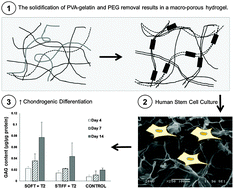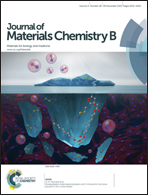Physically crosslinked polyvinyl alcohol and gelatin interpenetrating polymer network theta-gels for cartilage regeneration
Abstract
Theta-gels are hydrogels that form during the solidification and phase separation of two dislike polymers, in which a low molecular weight polymer behaves as a porogen and is removed through dialysis. For this study, interpenetrating polymer network (IPN) hydrogels were formed between polyvinyl alcohol (PVA) and gelatin using theta-gel fabrication techniques, i.e., in the presence of a porogen. The addition of gelatin to a PVA theta-gel, formed with a porogen, polyethylene glycol (PEG), created macro-porous hydrogels, and increased shear storage moduli and elastic moduli, compared to PVA–gelatin scaffold controls. A reduction in PVA crystallinity was verified by Fourier transform infrared (FTIR) spectroscopy in hydrogels fabricated using a porogen, i.e., PVA–PEG–gelatin, compared to PVA, PVA–PEG, or PVA–gelatin hydrogels alone. Van Geison staining confirmed the retention of gelatin after dialysis. A range of hydrogel moduli was achieved by optimizing PVA concentration, molecular weight, and gelatin concentration. PVA–gelatin hydrogels maintained primary human mesenchymal stem cell (MSC) viability. Soft (∼10 kPa) and stiff (∼100 kPa) PVA–gelatin hydrogels containing type II collagen significantly increased glycosaminoglycan (GAG) production compared to controls. PVA–gelatin hydrogels, formed using theta-gel techniques, warrant further investigation as articular cartilage tissue engineering scaffolds.

- This article is part of the themed collection: Bio-inspired and natural materials

 Please wait while we load your content...
Please wait while we load your content...